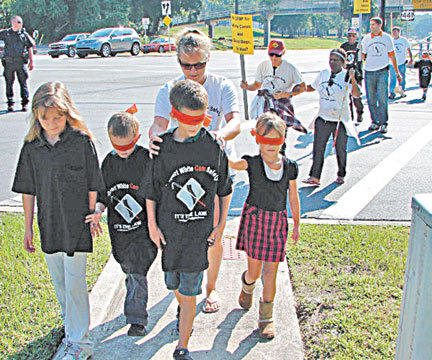11th annual white cane safety walk
This past Saturday dozens of area residents, young and old, many with their eyes blindfolded, learned what it was like to live a day in the life of a blind or visually impaired person as they made the annual trek from the now-vacant lot near Alachua’s fire station to the Troop 88 Boy Scout hut.
Every seven minutes another person loses their ability to see. Today there are 15 million blind and visually impaired people in the United States. And for 11 years, the Alachua County Council of the Blind (ACCB) in conjunction with local Boy Scout Troop 88, Alachua Police Explorers and the Alachua Lions Club have been educating the public about Florida’s White Cane Law.
Each October in the city of Alachua, the ACCB, scouts, Lions Club members and community leaders join for the annual trek from the now-vacant lot near Alachua’s fire station to the Troop 88 Boy Scout hut. The awareness campaign offers the general public a glimpse into life as a blind person with the hope that more people will adhere to the White Cane Law, Statute No. 316.1301. That law requires all drivers to come to a complete stop when approaching a blind or visually impaired pedestrian attempting to cross the street - and the visual demonstration is the white cane.
As on Saturday in years past, Alachua’s annual White Cane Walk kicked off with sighted participants taking a two-block walk along U.S. Highway 441 – while blindfolded. Organizers of the event led the group of area residents as they experienced a world of darkness. The Alachua community answered the challenge issued years ago by visually impaired Jack Varnon to “walk a mile in my shoes” through participation in the annual white cane safety awareness walk.
Saturday’s walk was a family affair for 10-year-old Webelos scout Jarrod Sanders whose younger brothers also attended the event.
“There was a surprise at the end of the walk for everyone – hotdogs and sodas and chips,” Sanders said.
The youngster also said he learned a lot about how challenging it is for a visually impaired person do the same things he takes for granted.
Imagine pouring a glass of water, counting money, or unlocking a door in total darkness. Yet, every day, millions of blind or visually impaired people do just that – and more. Consider using a computer, voting, or crossing the street in total darkness. Everyday tasks that sighted people take for granted present special challenges for the visually impaired, and unfortunately, in the case of crossing the street, can lead to injury or death.
Participants learned how a blind person counts out change without being able to see it and had the unique opportunity of having their names written in Braille.
The “blind walk” began 11 years ago as area resident Adam Boukari’s Eagle Scout project designed to create awareness about the Florida White Cane Law. Over the course of the past 11 years, the ACCB has teamed up with the Alachua Lions Club, Boy Scout Troop 88, Cub Scout Pack 88 and the Alachua Police Department (APD) to bring the message of safety to the public.
Among area residents on hand for this year’s walk were city officials including Alachua Mayor Gib Coerper, Commissioner Orien Hills, City Manager Traci Cain and Chief of Police Joel DeCoursey. This was just the latest such walk for Hills, who has the distinction of participating in the event each year, from the first step of the inaugural walk in October 2000.
This past Saturday dozens of area residents, young and old, many with their eyes blindfolded, learned what it was like to live a day in the life of a blind or visually impaired person.
Stop for the red-tipped white cane
Tools
Typography
- Font Size
- Default
- Reading Mode


